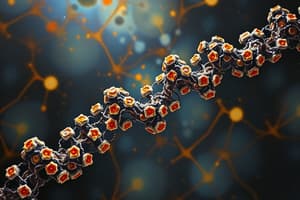Podcast
Questions and Answers
What is an important feature of the double helix of DNA?
What is an important feature of the double helix of DNA?
- The two base pairs have exactly the same geometry (correct)
- The irregular order of base pairs
- Lack of specificity in base pairing
- High diversity in protein structures
What contributes to the specificity of base pairing in DNA?
What contributes to the specificity of base pairing in DNA?
- Stacking interactions between the bases
- Hydrogen bonds between complementary bases (correct)
- Water molecules lining up on the bases
- Displacement of water molecules from the bases
How does the architecture of DNA differ from that of proteins?
How does the architecture of DNA differ from that of proteins?
- DNA has an overall relatively regular architecture (correct)
- DNA lacks specificity in base pairing
- Proteins exhibit stacking interactions between amino acids
- Proteins have exactly the same geometry in their structure
What is a fundamental feature contributing to the thermodynamic stability of the DNA double helix?
What is a fundamental feature contributing to the thermodynamic stability of the DNA double helix?
What force, in addition to hydrogen bonds, contributes to stabilizing the DNA double helix?
What force, in addition to hydrogen bonds, contributes to stabilizing the DNA double helix?
What is the consequence of adenine on one DNA chain pairing with thymine on the other DNA chain?
What is the consequence of adenine on one DNA chain pairing with thymine on the other DNA chain?
Which bases pair with each other in DNA?
Which bases pair with each other in DNA?
What gives DNA its self-encoding character?
What gives DNA its self-encoding character?
If one DNA chain has the sequence 5'-CATA-3', what would be the complementary sequence on the other chain?
If one DNA chain has the sequence 5'-CATA-3', what would be the complementary sequence on the other chain?
What type of pairing occurs between adenine and thymine, and guanine and cytosine in DNA?
What type of pairing occurs between adenine and thymine, and guanine and cytosine in DNA?
Why do the two polynucleotide chains in DNA have opposite 5’ to 3’ orientations?
Why do the two polynucleotide chains in DNA have opposite 5’ to 3’ orientations?
What is the main distinguishing feature of B-DNA compared to A-DNA?
What is the main distinguishing feature of B-DNA compared to A-DNA?
Under what conditions is A-DNA observed?
Under what conditions is A-DNA observed?
How many base pairs per turn does B-DNA have?
How many base pairs per turn does B-DNA have?
Which type of DNA structure is most commonly found in the cell?
Which type of DNA structure is most commonly found in the cell?
What structural feature allows amino acid side chains to recognize and bind to specific DNA sequences?
What structural feature allows amino acid side chains to recognize and bind to specific DNA sequences?
In what structure is DNA most closely corresponding to the average structure of DNA under physiological conditions?
In what structure is DNA most closely corresponding to the average structure of DNA under physiological conditions?
Flashcards are hidden until you start studying




